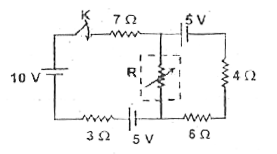Assertion : On cooling , ammonia liquifies first whereas CO2 requires more cooling .
Reason : Critical temperatures of ammonia and carbon dioxide are 405.5 K and 304.10 K respectively .
A
B
C
D
The correct Answer is:1
Step by step video & image solution for Assertion : On cooling , ammonia liquifies first whereas CO_(2) requires more cooling . Reason : Critical temperatures of ammonia and carbon dioxide are 405.5 K and 304.10 K respectively . by Chemistry experts to help you in doubts & scoring excellent marks in Class 12 exams.
Updated on:21/07/2023Topper's Solved these Questions
Similar Questions
Gases possess characteristic critical temperature which depends upon the magnitude of intermolecular forces between the gas particles. Critical temperatures of ammonia and carbon dioxide are 405.5 K and 304.10 K respectively. Which of these gases will liquify first when you start cooling from 500 K to their critical temperature ?
View SolutionGases possess characteristic critical temperature which depends upon the magnitude of intermolecualr forces between the gas particles, critical temperatures of ammonia and carbon dioxide are 405.5 K and 304.10 K respectively. Which of these gases will liquefy first when you start cooling from 500 K to their critical temperature ?
View Solution
Knowledge Check
Assertion :- On cooling ,ammonia lirquifies first whereas CO2 requires more cooling.
Reason :- Critical temperatures of ammonia and carbon dioxide are 405.5 K and 304.10 K respectively.AIf both assertion and reason are true and reason is the correct explanation of assertion .BIf both assertion and reason are true but reason is not the correct explanation of assertion .CIf assertion is true but reason is false .DIf both assertion and reason are false .Assertion: Aquatic species are more comfortable in warm waters than cold waters .
Reason: KH values for both N2 and O2 decrease with increase of temperatureAIf both assertion and reason are true and reason is the correct explanation of assertionBIf both assertion and reason are true but reason is not the correct explanation of assertion.CIf assertion is true but reason is falseDIf both assertion and reason are false
Assertion : NH3 is liquidities more easily than CO2.
Reason : Critical temperature of NH3 is more than CO2.
View SolutionAssertion : CO2 gas stronger intermolecular forces than CH4
Reason : Critical temperature of CO2 is more.
View SolutionAssertion : Critical temperature of CO2 is 304K, it cannot be liquefied above 304 K.
Reason : At a certain temperature, volume ∝1/ pressure.
View SolutionA solution containing 0.1 mol of naphthalene and 0.9 mol of benzene is cooled out until some benzene freezes out. The solution is then decanted off from the solid and warmed upto 353K where its vapour pressure was found to be 670mm. The freezing point and boiling point of benzene are 278.5K and 353K respectively, and its enthalpy of fusion is 10.67KJmol−1. Calculate the temperature to which the solution was cooled originally and the amount of benzene that must have frozen out. Assume ideal behaviour.
View SolutionIn the circuit shown the resistance R is kept in a chamber whose temperature. is 20∘C which remains constant. The initial temperature and resistance of R is 50∘C and 15Ωrespectively. The rate of change of resistance R with temperature is 12Ω/∘C and the rate of decrease of temperature of R is In(3/100) times the temperature difference from the surrounding (Assume the resistance R loses heat only in accordance with Newton's law of cooling) If K is closed at t = 0, then find the
(a) value of. R for which power dissipation in it is maximum.
(b) temperature of R when power dissipation is maximum
(c) time after which the power dissipation will be maximum

View SolutionAssertion At triple point, three stated (solid, liquid and gas) may co-exist simulaneously.
Reason For water, the values of pressur and temperature corresponding to triple point are 10 mm of Hg and 273.16 K.
View Solution
